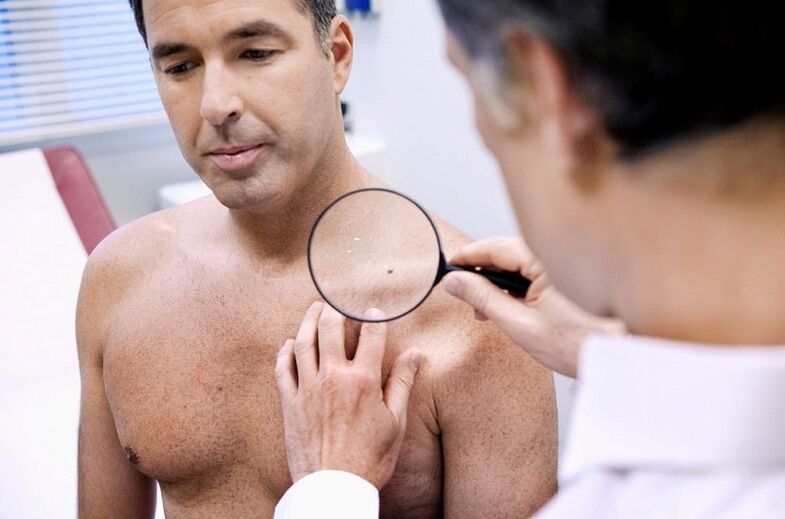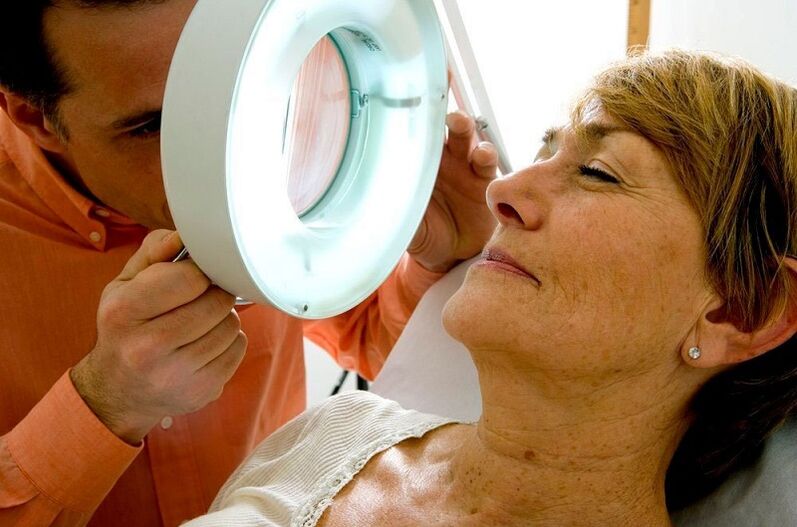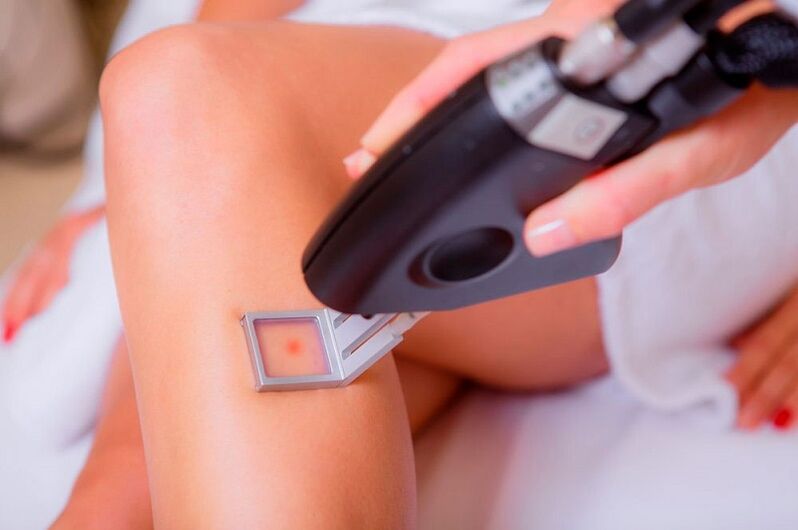Papilloma is a benign formation on the skin or mucous membranes caused by one of the many viruses of the Papovaviridae family. Human papillomavirus, or HPV, is the generic name for a group of uncoated DNA viruses that are transmitted in different ways. HPV infection can occur during sex, with microscopic damage to the mucosa and skin, during birth (from an infected mother to a baby).
Human papillomavirus in adults

Human papillomavirus (PVI) infection is quite common. Many studies show that more than 80% of the young population carries the disease. Infection in the body affects the squamous epithelium of the skin and can multiply over many years. Its different types, affecting the mucous membranes, cause the appearance of benign formations in the conjunctiva, mouth and genitals.
Papillomas in women
Human papillomavirus infection is equally threatening to men and women. But some types of pathogenic microorganisms will cause great dangers to the health and lives of women. Many studies have shown that HPV can cause cervical cancer.
Papillomavirus in pregnant women
A strong weakening of the immune system and a hormonal imbalance can provoke an active reproduction and symptomatic manifestations of the papilloma virus, which has been inactive in the body for a while. long time. During pregnancy, the appearance of papillomas on the skin and mucous membranes can be frightening to expectant mothers. In this case, the woman should be urgently advised by a gynecologist.
HPV is not a contraindication to conception, although during childbirth there is a high chance of infecting the baby.
Papillomas in men
Papillomas in men have mostly no clinical manifestations. But men are also the source of infection and infection to sexual partners. In the normal state of the immune system, the activity of pathogenic microorganisms is reduced to zero. But with immunodeficiency, the situation may change, and the presence of papilloma virus in the blood begins to become active and in some cases strong self-manifestation.
The sexually transmitted infection that causes genital warts affects both men and women equally. HPV 16 and 18, which can cause cervical cancer in women, is rarely detected in men. When entering the body, this papilloma virus stays in the urethra for a while, after which it will be eliminated by itself because there is no favorable environment to reproduce. Male genital warts can appear:
- most often on the corolla furrow and penile groove;
- less often on the shaft of the penis or on the head;
- in the area of the outer hole of the urethra;
- in the urethra itself;
- in the area around the anus and in the anal canal.
Compared with women, papillomas in men rarely cause the development of cancer. Diagnosing the HPV virus in the male body is also difficult.
Human papilloma in children

Papillomas in women and men, as well as in children, affect all organs with a transitional or transitional epithelium. This can be the skin, the oral mucosa, the pharynx, and the respiratory tract. Transmission of the human papillomavirus in childhood occurs:
- during intrauterine development of the fetus;
- when the baby passes through the mother's birth canal;
- household contact from parent to baby;
- in teams (kindergarten, school, sports and development sections).
But even when a child is infected, the genital warts virus from the child's body can also be eliminated by itself after a certain time. If this does not happen immediately, after the onset of puberty, in many cases the papilloma on the body and mucous membranes will disappear.
Papillomas on the body
Most common in children is the clinical presentation of a human papilloma in the form of common warts or warts in the vulva. They are usually located on the inside and back of the palm or in the knee area. But often appear papillomas with a protruding keratinized surface on any part of the body. They are non-irritating and painless. With trauma, such formations can begin to hurt and bleed.
Papillomas in children on the laryngeal mucosa

The most common diagnosis in children, if a human papilloma virus is present in their body, is a laryngeal papilloma. If the infection occurs during childbirth and the infection is transmitted from mother to child, its external manifestations are usually observed before the baby is 5 years old. The cause of laryngeal papilloma is the penetration of HPV types 6 and 11 into the child's body.
Types of infection, types of PVI and their manifestations
The papilloma virus is very contagious. Its transmission patterns are varied, which significantly increases the number of people at risk. More than a hundred types of pathogens for genital warts are classified by modern medicine into many different categories, characterized by transmission pathways, appearance and health hazards.
How are papillomas in humans spread?
The infection of the papillomavirus virus can occur through sexual intercourse, domestic use or during childbirth, in which pathogenic microorganisms are passed from mother to child. A person can also become self-infected with one of the papillomaviruses. Self-implantation can occur with mechanical damage to the skin or mucous membranes, for example, during hair loss.
Papillomas: the cause of infection through sexual intercourse
For a papillomavirus infection, the reasons can be different. But one of the most common is sexually transmitted. Moreover, you can get infected not only through the vagina but also through anal sex and even oral sex. There are about 40 types of papillomaviruses, which are caused by frequent sexual partner changes and early initiation of sexual activity.
Viral transmission in water
The implication of HPV is that its transmission in the family is very high. Several factors can increase the risk of papilloma virus infection, the reasons for this are different, for example:
- the presence of cuts and scrapes in the skin, as well as excessive dryness in the skin with the appearance of cracks;
- diseases that weaken the immune system (HIV infection, flu, herpes);
- Long-term use of powerful drugs that impair the function of the immune system.
Infection of the newborn during childbirth
Like many other genital infections, the papilloma virus can be passed from mother to baby during childbirth. In addition, the baby can be infected in the prenatal period. If a pregnant woman is a carrier of HPV type 6, 11, 16, or 18, the pathogen most often affects the baby's oral mucosa. These types of papilloma infections often cause the development of a laryngeal papilloma in adolescence.
Many women mistakenly believe that a caesarean section will keep their baby from getting infection. But even in this case, the transmission of the papillomavirus remains, and pathogenic microorganisms can be transmitted across the placenta.
How is the human papilloma virus?

HPV is a group of viruses that cause the development of benign tumors on a living organism and under a number of factors that lead to their malignancy. According to the location, papillomas can be on the skin or on the genitals. Such tumors can manifest themselves:
- Common warts, characterized by a dense, rough surface with additional growths. The size of such tumors is from 1 mm. As a rule, their appearance is observed on the palms of the hands and fingers, in the knee area (mainly in children), but such papillomas can also appear on the body. The spread of common warts is facilitated by a rapid decline in immunity.
- Plantar warts cause a feeling of particular discomfort and pain. The pathogens of such tumors are several types of HPV: 1, 2, and 4. On the surface, calluses may be mistaken for regular calluses. Their sizes are small at first. But then the papilloma develops and may appear more nearby tumors.
- Flat warts appear in the presence of HPV types 3 and 10. Such tumors practically merge with the skin, which may be round or polygonal in shape. Often their appearance is accompanied by itching, redness and soreness.
- Typical filaments of virus carriers are fifty years old or older. Such papillomas can appear on the eyelids, on the body, in the armpits, . . . Their length is sometimes up to 6 mm.
- Genital warts develop on the basis of HPV 6 and 11. In women, such tumors can be localized in the anus and on the rectal mucosa, on the vaginal wall, in the uterus and in the negative. households, in the groin area.
Types of papillomas

The main danger of the virus that causes papilloma in men and women is that in modern medicine it is considered to be a carcinogen. About a third of more than a hundred types currently affect the male and female genitals and cause the development of genital warts.
Classification of cancer risk
An unshielded DNA virus can not only cause uncontrolled division of skin cells and mucous membranes, but also contribute to tumor malignancy. However, not all papillomas lead to cancer development. Various factors may increase the likelihood of developing cancer-causing diseases:
- initiate sexual activity earlier, change sexual partners often, and enjoy anal sex;
- presence of sexually transmitted infections that affect the genitals, both women and men;
- smoking and abuse of alcohol, negatively affecting the state of the immune system and provoking the appearance of papillomas in an intimate place and other parts of the body;
- use of an intrauterine device as a method of contraception, as well as long-term use of birth control pills;
- Endometriosis and other diseases of the organs of the female reproductive system.
To determine which type of papilloma virus will help make a complete diagnosis, the need to be determined by a doctor.
Viruses do not cause cancer
Among the many types of HPV, there is a group of pathogenic microorganisms that do not pose a particular health hazard. Noncancerous HPV types include papillomavirus of genotypes 1, 2, 3 and 5. Their presence in the body causes the appearance of various skin warts.
- Common, flat warts on the hands and soles of the feet that appear when infected with genotype 1 HPV.
- Genotype 2 virus leads to the appearance of flat and rough shapes on the hands.
- HPV 3 causes uncontrolled cell division of the skin and the formation of flat warts and juvenile warts.
Viruses cause low risk of cancer
Human papillomas with a low risk of cancer develop when the HPV 6, 11, 42, 43 and 44 virus enters the body. The most common viruses are genotypes 6 and 11. They account for about 90% of all infections. These pathogenic microorganisms cause the formation of a special type of genital papilloma - genital warts. Their position on the mucous membrane of the cervix or penis in men has some risk of malignancy of formation.
Papilloma virus with a high risk of causing cancer
Genotypes HPV 16, 18, 31, 33, 35, 39, 45, 51, 52, 56, 58, 59, 66 and 68 have a high risk of causing cancer. More than 70% of infections are infections with viruses of types 16 and 18. Type 18 papillomas are commonly found in the diagnosis of adenocarcinoma. Pathogenic microorganisms of these types stimulate the development of cancers of the cervix, anus, vagina, vulva, or penis.
Virus classification according to the localization of the manifestations

Outward manifestations of papillomas in women and men can be observed on the open skin of the body, on the soles of the feet, as well as on the skin and mucous membranes of the genital area. Injury can be local, and in severely immunocompromised people, multiple nests of cancer are often observed. After the virus has entered the body, it is possible to note three stages of its development:
- at the latent stage, clinical manifestations of the infection are not observed;
- with a subclinical form, symptoms and morphological signs are minimal;
- Clinical stage implies the appearance of papillomas, dysplasia and malignancies.
External manifestation characteristics depend on the type of virus that has infected the patient's body.
Papillomas on the neck
Papillomas on a person's neck can manifest themselves throughout their lives. Such formation is benign and is only psychologically irritating. In addition, small lumps in thin legs can get caught in clothing, injured, and cause pain and bleeding. If such problems arise, you should remove the papilloma on the neck.
Papillomas in an intimate place
The papilloma is in an intimate place called genital warts. It can be localized in women on the vaginal mucosa or cervix, in men - on the penis. In addition, genital warts can develop on the tissues of the anus. All papillomaviruses that infect the genitals can be divided into:
- the virus has a high level of carcinogenicity (HPV 16, 18, 31, 33, 35), which significantly increases the risk of malignant cancer, but does not cause genital warts;
- The papillomavirus, with a low level of cancer (HPV 6, 11), is the cause of genital warts.
Papillomas on the eyelids

Eyelid papilloma usually develops in adults who carry the HPV virus. They are usually located on the edge of the lower eyelid. The lumps may be in the form of cauliflower. The dangers of such formation lie in their frequent direct UV exposure and their habit of rubbing their eyes with dirty hands. In the latter case, the risk of infection with papilloma in the eyelids is significantly increased. The color of the lump may be fleshy or dark.
Papillomas: treatment and diagnosis
Once in the body, the papillomavirus can function in different ways. The body's response depends on the type of virus itself, the immune status, the presence of concomitant diseases, and other factors determined individually for the patient. Therefore, there are three main types of activity of the papillomavirus in the human body:
- Pathogenic microorganisms enter the bloodstream and act passively. In this case, a person is a carrier of the virus and can infect those in close contact with him.
- The virus enters the body but does not integrate into the chromosomes of cells, but at the same time stimulates the uncontrolled division of skin and mucous cells and forms papillomas and warts.
- HPV enters cells, altering their structure and becoming the cause of malignant tumors.
In each case, specific diagnostic and therapeutic methods are needed to identify the virus.
Diagnosis of the human papilloma virus
The main type of diagnosis is an out-patient examination. It is relevant if the infection is manifested by the formation of papillomas (genital warts) on the external genitalia. To determine in the laboratory the presence of HPV and its type, help:
- PCR method. Such a test is highly sensitive to detect infection in the subclinical or latent stage of development.
- Digene test. Analysis of hybridization revealed 13 strains of virus with high carcinogenicity and 5 varieties with low carcinogenicity. As a rule, for a more accurate diagnosis of papillomavirus, the digene assay is combined with cytological studies.
In men, the diagnosis of papilloma virus is especially difficult. Screening for male patients is not relevant. In this case, it is possible to diagnose only when there are external clinical manifestations of the disease.
Papillomas: how to remove external manifestations
If a person has papillomas on the body, the doctor will tell you how to get rid of them. It is not worth trying to deal with these external manifestations on your own, as it will lead to harmful health consequences, namely infection. Removal of papillomas is necessary for a number of reasons, namely:
- some types of papilloma can develop and become malignant over time;
- the presence of the tumor brings about psychological discomfort to the patient;
- papillomas on the body and genital area can be injured and bleed.
However, even so, only a doctor can determine the need to remove the papilloma. To do this, you should contact a dermatologist or a dermatologist.
Removing papillae with a laser

Laser removal method is highly effective. Its use allows you to quickly get rid of benign tumors. Laser cutting of shapes about 5 mm in diameter only takes a few minutes. However, in some cases, it may be necessary to remove the papilloma in several stages. The procedure is performed with local anesthesia. The tissue is removed by laser resection that is inconsistent with the histology.
How to remove papillomas by radio wave method
Radio removal is a completely painless and quick way to remove a papilloma. During this process, the tumor is removed in the area of its facility. Once removed, a small dark crust remains in its place. The removed material is suitable for histological analysis. When deciding how to remove a papilloma without the risk of scarring, radio wave therapy is the best choice for the patient.
Remove papillae with liquid nitrogen
Referring to the appearance of papillomas and the method of their removal, it is impossible not to mention liquid nitrogen removal method, also known as cryosurgery. This method of removing papillae from the body is quite effective, but the possibility of recurrence of external manifestations remains. During the procedure, low temperature nitrogen affects the papilloma cells, causing them to freeze. This method is characterized by minimal trauma and lack of pain sensation.
Capacitor condenser
Coagulation - removal of papillae from the body by purposefully applying an electric current to the tumor's tissue. This method is highly effective (80-95%). Its main advantage is that after removing the formation from the papilloma, it leaves no trace. Within a week, only a small layer of scabs remain on the skin, which will disappear after menstruation. You can't tear it up yourself.
Medicine treatment

Removing papillomas with a laser or any method prescribed by a doctor is only a solution to external problems that are both a cosmetic, psychological, or physical discomfort. Tumor removal methods have nothing to do with the fight against the papilloma virus, the treatment of the disease requires a synthetic approach.
Today, there is no specific drug to effectively remove the papilloma virus from the body and treat its external manifestations. Comprehensive treatments practiced by medicine today are:
- laser papilloma removal, liquid nitrogen and other benign tumor resection methods;
- immunotherapy aimed at activating the body's natural protective functions;
- strengthen the body in general, take a multivitamin, maintain a healthy lifestyle.
By contacting your doctor and passing all the necessary studies, you can confirm or deny the presence of the papilloma virus in the body, learn how to get rid of the tumor and reduce the risk of recurrence. their appearance.
HPV and immunity
Once in the body, the HPV virus may not manifest for a long time. Papillomas on the eyelids, neck, body or in the intimate area, which are outward manifestations of viral activity, appear with a sharp decrease in immunity. Therefore, the risk of papillomas on the neck, skin and mucous membranes throughout the body is significantly increased when:
- infectious disease transfer or surgical intervention;
- pregnancy and lactation;
- constant stress, hypothermia and other factors that negatively affect immunity;
- long-term use of some drugs;
- presence of genital tract infection.
Any factor that weakens the immune system can contribute to the replication of the virus in the blood. Therefore, it is important not only to know how to get rid of papillomas but also to know how to strengthen the immune system, preventing their reappearance.
Papillomas: alternative treatment
If a papilloma appears on your body, absolutely not remove it at home. For safe and effective treatment, you need to see your doctor. The specialist will prescribe the necessary studies and based on their results to develop a treatment regimen. Under this program, under the supervision of a doctor, the patient can treat the papilloma virus at home.
Prevention of HPV
The prevention of genital warts virus by traditional and folk methods to minimize the risk of infection. Also has the effect of preventing the multiplication of viruses in the body and the formation on the skin and mucous membranes of external manifestations such as papillomas in intimate places, on the neck, eyelids, palms. , soles of the feet, v. v.
Prevention of human papillomavirus infection
So one day you are not faced with the question of how to get rid of papillae, you need to remember about the main measures to prevent viral infection. In intimate relationships with a new partner, unfortunately, using condoms and other birth control methods do not protect the body from the HPV virus. Only maintaining a monogamous relationship with a trusted partner can help reduce the risk of infection.
To prevent papilloma virus infection, traditional methods are not as effective as traditional methods. Modern scientists have developed several vaccines that significantly reduce the risk of infection with highly cancer-causing types of HPV (6, 11, 16 and 18).
The best age for vaccination is between 10 and 25 years old. Its effectiveness is calculated in the range of 6, 5 years.
Prevention of symptoms of HPV

To suppress papilloma virus activity, effective replacement therapy with its recipes to strengthen the immune system. But before using them, it is necessary to consult a doctor. Also, don't forget about the safest and most effective methods to increase the body's natural protective functions through sports, healthy, hard eating.
Everyone can prevent papillomavirus at home. Take care of your health, do not forget to regularly visit your doctor to prevent disease and strengthen your immunity.

























